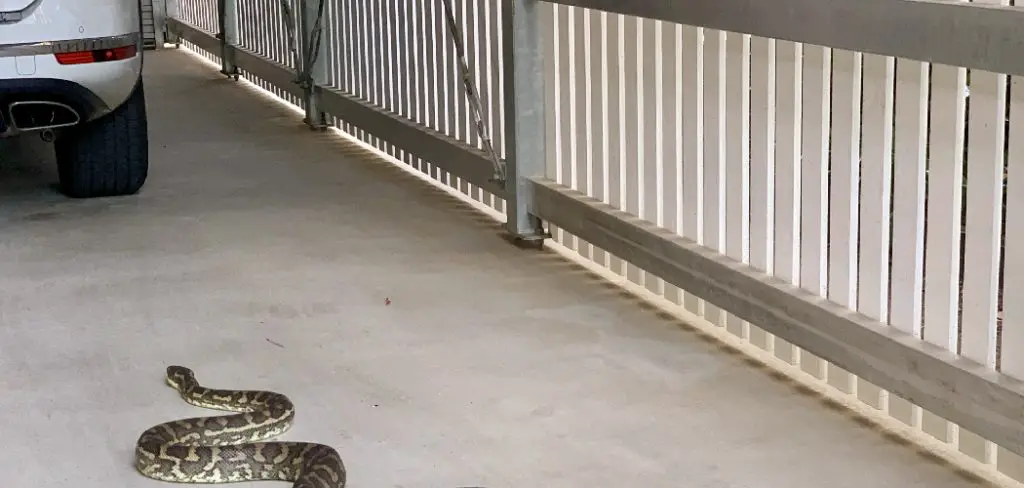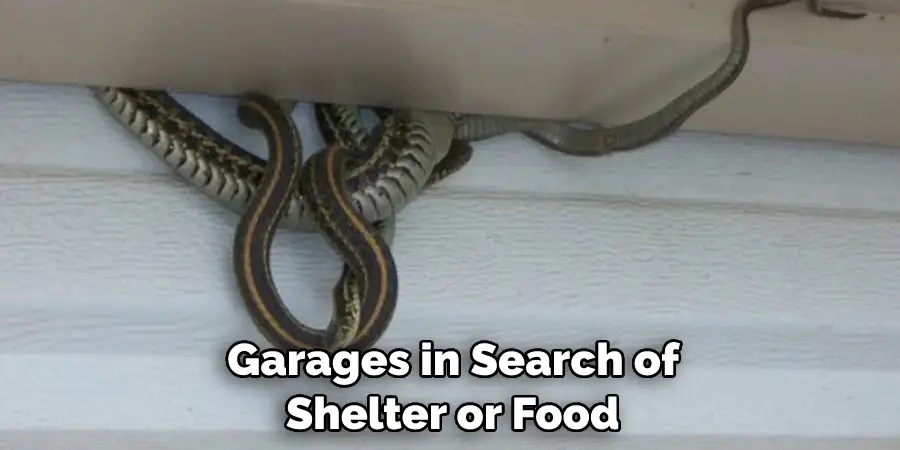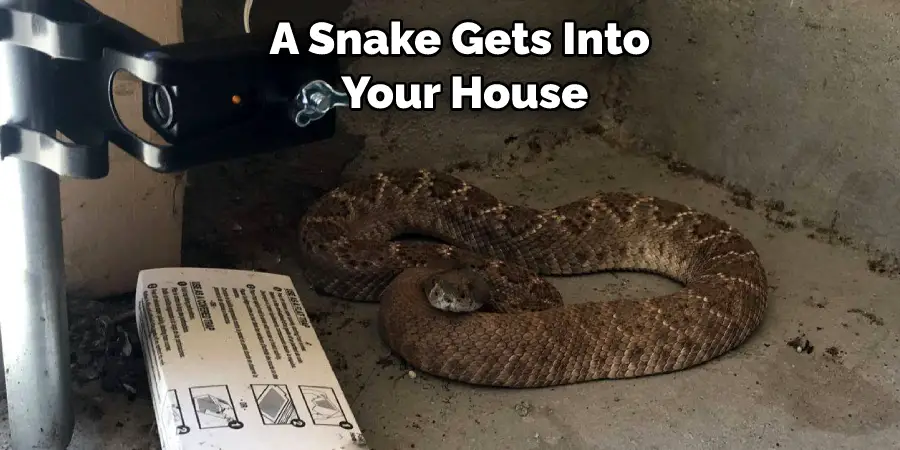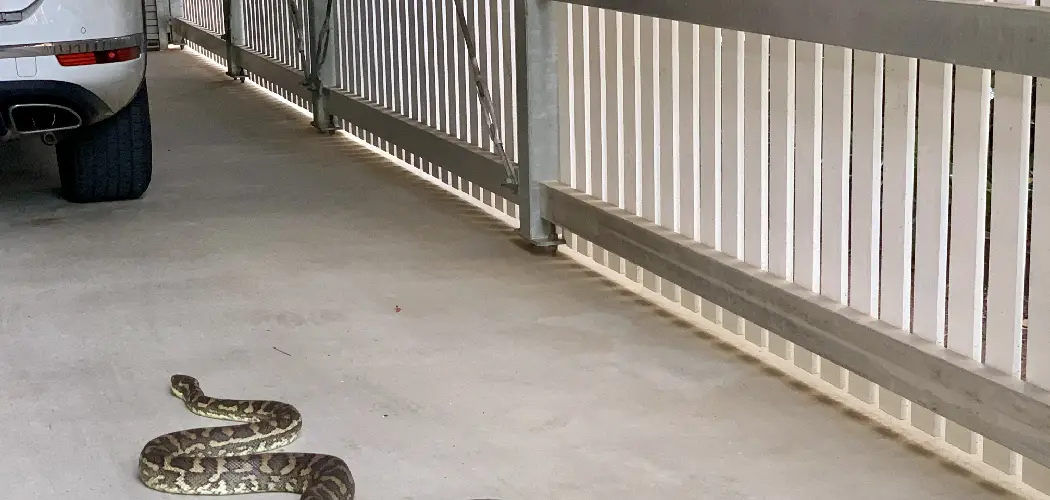If you have a garage, you know that it can be a great space for storage – but it can also be a perfect place for wild animals to take up residence. Snakes are especially common in garages; if you’re not careful, they can easily find their way into your home.

Thankfully, there are some steps you can take to snake-proof your garage and keep them out for good. Check out the post below to learn more about how to snake proof your garage.
Summary: Snakes can be a potential problem in garages, as they are attracted to the shelter and heat that garages provide. To snake-proof, your garage, start by sealing all cracks and crevices with caulk or weatherstripping. Keep the garage door closed as much as possible, and install door sweeps to prevent snakes from slipping in under the door.
Why Should You Snake Proof Your Garage?
For anyone who lives in an area with snakes, the idea of one getting into your garage is enough to send a shiver down your spine. Not only are they creepy, but they can also be dangerous – even deadly in some cases.
Just the thought of a snake coiled up in the corner of your garage is enough to make your skin crawl. However, there are several good reasons to take steps to snake proof your garage.
First, it will help to keep your family safe from harm. Second, it will deter snakes from using your garage as a refuge, which could attract other pests. Finally, knowing that your garage is snake-free will give you peace of mind.
While there is no guarantee that snake-proofing your garage will keep every snake out, it is certainly worth the effort.
How to Snake Proof Your Garage Step-by-Step Guide
If you have a garage, there’s a good chance you’ve also got a snake problem. Snakes are known to enter garages in search of shelter or food and can be a real nuisance. Fortunately, there are some things that you can do to snake proof your garage and keep these pests out.

Step 1: Inspect Your Garage for Entry Points
Begin by thoroughly inspecting your garage for any cracks, gaps, or openings that could allow snakes to enter. Pay close attention to the garage door, windows, vents, and any other potential entry points. Note the locations of any openings that need to be addressed.
Step 2: Seal Cracks and Gaps
Once you’ve identified any openings in your garage, use caulk, expandable foam, or weatherstripping to seal cracks and gaps. Ensure that the sealing material is appropriate for the surface and can withstand the elements. For larger openings, consider using hardware cloth or steel mesh to cover the area, securing it in place with screws or nails.
Step 3: Install Door Sweeps or Thresholds
To prevent snakes from entering through gaps under your garage door, install door sweeps or thresholds. These can be easily attached to the bottom of the door and create a barrier that prevents snakes and other pests from entering.
Step 4: Repair or Replace Damaged Screens and Vents
Inspect any screens or vents in your garage for damage, such as holes or tears. Repair or replace damaged screens and vents, ensuring they are properly sealed to prevent snake entry.
Step 5: Clear Debris and Clutter
Snakes are attracted to areas that provide shelter and hiding spots, such as piles of debris, clutter, or overgrown vegetation. Clear your garage and the surrounding area of any unnecessary clutter, and maintain a clean, organized space to reduce the likelihood of snakes seeking refuge.
Step 6: Maintain Your Yard
Keeping your yard well-maintained can also help deter snakes from entering your garage. Regularly mow your lawn, trim bushes and shrubs, and remove any piles of leaves, grass clippings, or other debris. Additionally, keep firewood, compost piles, and other potential snake habitats away from your garage.
Step 7: Remove Food Sources
Snakes are attracted to areas with abundant food sources, such as rodents or insects. Take steps to eliminate these food sources in and around your garage by setting traps, using rodent repellents, or hiring a pest control professional to address the issue.
Step 8: Use Snake Repellents
Consider using snake repellents in your garage and around the perimeter of the building. There are various types of snake repellents available, including granules, sprays, and electronic devices. While their effectiveness can vary, they may help deter snakes from entering your garage.
Step 9: Install Snake Fencing
If you live in an area with a high snake population, consider installing snake-proof fencing around your garage or property. This type of fencing is designed with small mesh openings and a smooth surface that makes it difficult for snakes to climb or pass through. Ensure the fencing is installed correctly, with no gaps at the base, and extends several inches below ground level.
Step 10: Regularly Inspect Your Garage
Regularly inspect your garage for signs of snake activity, such as shed skins or droppings. Promptly address any snake sightings or evidence of their presence by contacting a professional snake removal expert or using appropriate snake removal tools and techniques.
Step 11: Educate Your Household Members
Ensure that all members of your household are aware of the potential risks associated with snakes and know how to properly identify and respond to snake encounters. Teach children to respect and avoid snakes and to alert an adult if they see one in or around the garage.
Step 12: Consult Local Wildlife Experts
If you are unsure about the best methods for snake-proofing your garage, consult local wildlife experts or snake removal professionals. They can provide guidance on the most effective strategies for your specific location and the types of snakes native to your area.
By following these steps, you can significantly reduce the likelihood of snakes entering your garage and create a safer environment for you and your family. Regular maintenance, sealing entry points, and implementing preventative measures will help deter snakes and protect your property.
Step 13: Monitor and Modify Your Strategies
Continuously monitor the effectiveness of your snake-proofing strategies and modify them as needed. If you discover that certain methods are not working or if new entry points emerge, take the necessary steps to address the issue and improve your garage’s snake defenses.
Step 14: Know Your Local Snake Species
Familiarize yourself with the snake species native to your area and learn to identify potentially venomous snakes. Understanding the types of snakes you may encounter can help you better prepare for and respond to snake sightings in or around your garage.
Step 15: Consider Natural Deterrents
Planting natural snake deterrents, such as marigolds, lemongrass, or plants from the Allium family (garlic, onions, chives), around your garage and yard can help keep snakes at bay. While these plants may not be completely effective, they can contribute to a multi-pronged approach to snake-proofing your garage.
Step 16: Create a Barrier with Gravel or Rocks
Snakes prefer to avoid surfaces that are uncomfortable to slither across. Creating a barrier of coarse gravel or rocks around the perimeter of your garage can help deter snakes from approaching the area.
Step 17: Install Outdoor Lighting
Snakes are more likely to avoid well-lit areas. Install outdoor lighting around your garage to help deter snakes and other pests. Motion-activated lights can be particularly effective, as they only turn on when movement is detected, potentially startling snakes and causing them to retreat.
Step 18: Keep an Emergency Snake Bite Kit
In the unlikely event that a snake does enter your garage and someone is bitten, it’s essential to have a snake bite kit on hand. These kits typically include a suction device to help remove venom, a tourniquet, and other first aid supplies. Familiarize yourself with the proper use of the kit and ensure all household members know where it’s stored.
By implementing these steps and remaining vigilant, you can effectively snake-proof your garage and reduce the risk of unwanted encounters with snakes. Keep in mind that no method is foolproof, but a combination of preventative measures, regular maintenance, and education will go a long way in creating a safer environment for you, your family, and your belongings.
How to Protect Your Home From Snakes
Stepping into your backyard should be a peaceful experience. You should be able to listen to the birds singing and smell the flowers blooming, not worry about what kind of creatures may be lurking in the grass. But unfortunately, for many homeowners, snakes are a very real concern.
These creatures can range in size from a few inches to several feet, and their bites can be both painful and dangerous. However, if you’re worried about snakes invading your yard, you can take a few steps to deter them.
First, make sure your property is well-maintained. Keep the grass trimmed and remove any debris that could shelter snakes. Second, consider installing a fence around your property. This will help keep snakes out while also giving you peace of mind.
Finally, be sure to educate yourself on snake identification and behavior. Knowing what kinds of snakes are common in your area and how to react if you encounter one will help keep your family safe from harm.
What to Do if You Encounter a Snake in Your Garage
If you happen to see a snake in your garage, there’s no need to panic. More often than not, snakes are more afraid of you than you are of them. However, it’s still important to exercise caution and take appropriate measures to ensure your safety.
The first step is to identify the type of snake. If it’s a venomous species, such as a rattlesnake or copperhead, it’s best to call your local wildlife authorities for assistance. If it’s a non-venomous snake, you can try to capture it yourself using a long stick or pole. Once you have the snake under control, you can release it into the wild away from your home.

Remember, snakes play an important role in the ecosystem, so it’s best to leave them alone if possible. But if you find yourself face-to-face with one, there’s no need to worry—stay calm and act accordingly.
Tips for Keeping Snakes out Of Your Garage
If you’re like most people, the last thing you want to find in your garage is a snake. These slithering creatures can be dangerous, and their presence can be a major source of anxiety. Luckily, you can take a few simple steps to discourage snakes from taking residence in your garage.
First, ensure that your garage area is free of potential hiding places, such as thick underbrush and piles of leaves. Second, seal any cracks or holes in the foundation or walls of your garage, as these can provide entry points for snakes.
Finally, keep the garage clean and free of clutter, as this will discourage snakes from using it as a hunting ground for rodents. By taking these precautions, you can help to ensure that your garage remains snake-free. Keep reading for more information about how to snake proof your garage.
What to Do if A Snake Gets Into Your House
Picture this: you mind your own business, lounging on the couch and flipping through channels when suddenly, you see a snake slithering across your living room floor. Or maybe you’re in the kitchen, getting ready to make dinner, when you spot a snake underneath your sink.
If you find yourself face-to-face with an unwanted reptilian visitor, there are a few things you can do to remove it from your home safely. First, try to stay calm. It’s important not to startle the snake, as it could cause it to become aggressive. If possible, gently guide the snake out of the room using a broom or dustpan.
Call animal control or a local wildlife removal service if the snake is too big or too agitated to be caught safely. In the meantime, try to keep the snake in one room by closing doors and windows. And whatever you do, resist the urge to kill the snake – in most cases, it’s more afraid of you than you are of it!
What Is the Cheapest Way to Snake Proof Your Garage?
There are a few different ways to snakeproof your garage, but the cheapest way is to keep the area clean. Snakes are attracted to places where they can find food and shelter, so if your garage is full of clutter, it’s more likely to be appealing to them.
Start by removing any old boxes or unused furniture, and then make sure to sweep and vacuum regularly. You should also seal any cracks or holes in the walls or foundation, as this will give snakes a way to get inside.
By taking these simple steps, you can make your garage less inviting to snakes and help keep them out.
Frequently Asked Question
What Is the Easiest Way to Snake Proof Your Garage?
Installing a snake guard is the easiest way to snakeproof your garage. Snake guards are metal or plastic barriers placed at the bottom of your garage door. They will help to prevent snakes from entering your garage.

How Much Does It Cost to Snake Proof Your Garage?
There is no set cost for snake-proofing a garage, as the price may vary depending on how much work needs to be done. However, hiring a professional to snake proof your garage is likely expensive, so it may be worth trying to do it yourself.
Conclusion
Snakes can be a nuisance, but they are also beneficial in the garden. By understanding their habits and taking some easy precautions, you can keep them out of your garage and live harmoniously with these slithering creatures. Thanks for reading our post about how to snake proof your garage. Have you ever encountered snakes in your garage? How did you deal with it?
I am Rick. I grew up helping my dad with his handyman service. I learned a lot from him about how to fix things, and also about how to work hard and take care of business. These days, I’m still into fixing things- only now, I’m doing it for a living.
I’m always looking for new ways to help people grow and develop. That’s why I have created this blog to share all my experience and knowledge so
that I can help people who are interested in DIY repair.

